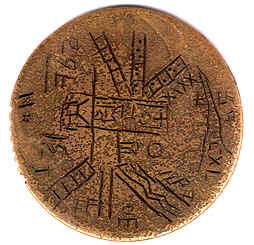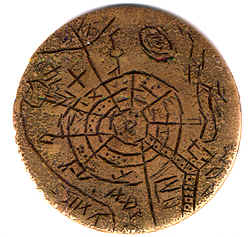|
Spider Rock Discs of Central Texas
|
|
Sometime between 1902 and 1910 three mysterious stones were
discovered in three different Central Texas Counties by Dave M. Arnold and local land
owners. All three discoveries sparked extensive treasure hunts, two of which were financed
by Dr. Caleb Lafon Terrell of Haskell, Texas, until his death on May 8, 1909 . Each stone
bore hieroglyphic symbols that have not yet been totally deciphered, even at this late
date. (1)
Throughout the last century, into the current period, treasure hunters, a history professor, archeologists, ranchers, a lock smith, mechanical engineer, logistics specialists, a postman, authors, museum personnel and a long list of others have sought to unravel the purpose of the stones and interrupt their cryptic symbols. (2) Bill Townsley became interested in this Texas mystery in 1989, when George W. Copeland, (Ft. Worth, Texas), W.T. (Bill) Farmer (Mineral Wells, Texas), Tom Jones (Arlington, Texas), Raymond Boyle (Mineral Wells), Terry Hutson (Abilene, Texas) and Bob Odom (from Tennessee) were using heavy earth moving equipment northeast of Clyde, Texas, in Callahan County, near the site of the original 1902 discovery of the Clyde Spider Rock.(3) A second stone was discovered between 1902 and 1905 near Aspermont, Texas, in Stonewall County, near the Salt and Double Mountain Fork of the Brazos River. Then about 1910 the third stone was discovered near Rotan, Texas, Fisher County, in the proximity of Gyp Creek. All three rocks bear some of the same symbols. As example, a spider web design is found on either the front or back side of all three stones. Cut along the edge of the Rotan Spider Rock is the numeral "94", the same appears on the Aspermont Spider Rock. "71" written as an Arabic numeral on the Clyde Spider Rock appears as a Roman numeral on the Aspermont Spider Rock. Capital "F"s appears on all three stones. The numeral "29" appears on both the Rotan and Clyde Spider Rocks, as do the letters "PO". "CXF" appears on both the Aspermont and Clyde rocks. (4) Dr. Duane K. Hale, a Professor of History at Cisco Junior College, Abilene, Texas, interviewed C. Ormin Duke of Rotan, Texas, in October of 1971. Duke had in his possession a disc, he claimed, he had found in the 1960’s near Kiowa Peak [pictured above]. Reporting in Treasure, Vol. 21 Number 2, February, 1990, Hale, Robert Kyker and Johnny Terrell write, "It (the disc) definitely linked the Clyde site with the Aspermont site, for on one side it had the Clyde map cut and on the other side it had the Aspermont map." (5) Reference 1991/92 Great Plains Journal (an annual interdisciplinary publication of the Institute if the Great Plains, Lawton, Oklahoma), Steve Wilson, Editor/Director, writes on page 82, "Neither etching on the copper disc is a duplicate of the stone maps, but are similar enough to cause one to ponder its purpose." Wilson says Dan Ferris (of Rotan, Texas) discovered the metal disc on the east side of Kiowa Peak in Stonewall County, Texas. (6) R. E. Sherrill, a Haskell, Texas business man and member of the Texas Folk-Lore Society recorded in 1924 the events of the 1907-1908 treasure hunt, "Nearly every man of that searching party of seventeen years ago was a friend of mine. At one time the party believed that they were within a foot or two of their treasure, but they feared to uncover it before they had made arrangements to take care of it... they wished, to entrust it to our private vault, where no one would suspect its presence." (7) Of equal interest is a discovery made by rancher, B. Hendrix, who lived west of Knox City, Texas, in 1971. In the cedar breaks near his property B. Hendrix discovered a religious medallion that bore the date 1647. (The date is no longer legible. Dr. Hale surmises this is due to Hendrix having carried it in his pocket or billfold, for a period, after it discovery). (8) In September of 1998, Bill Townsley and George Copeland traveled from Ft. Worth, Texas, to O’Brien, Texas, to interview Vivian Hendrix (B. Hendrix’s widow). Townsley, Copeland and Ray Penman (of Knox City, Texas) photographed the medallion. Printed on the artifact is "S.PATER BENEDICTVS. SILVESTCON SILF.". Ms. Hendrix told the trio, prior to her husband’s death, he had given another medallion to an area priest. Ms. Hendrix could not remember what was depicted on that object, but did remember that one of the medallions had been found in a cave. (9) In September of 1995, Bill Townsley located W. L. Duke (C. Ormin Duke’s nephew). Although C. O. Duke was deceased, W. L. Duke put Townsley in contact Ormin’s widow. Townsley learned from Mrs. Duke that her daughter, Joanne, still had the disc and it was stored in a safety deposit box in Abilene, Texas. For a little over two years, Townsley attempted to purchase the disc from the Duke family. In early November of 1997, David Auldridge (of Mansfield, Texas) telephoned Ms. Duke, and learned the family had decided to sell the disc. On 26 November 1997, Townsley met with Mrs. Duke and her daughter in Abilene, Texas, where he purchased the mysterious artifact depicted with this article. (10) We do not know what the three stones (the three Spider Rocks), found in Central Texas represent. We do not know who carved the intricate symbols depicted on them, nor do we know why someone would cut replicas of two of the stone maps (the Clyde map and the Aspermont map) on a disc a mere one-eighth-inch-thick and one and three quarters inches in diameter, then loose it or place it on the east side of Kiowa Peak (for centruies a historic landmark for travelers). Possibly the whole thing is a hoax, but it would certainly have taken a considerable amount of time for an individual or individuals to conceive and carry it out. Perhaps you have found a stone or metal artifact, located a document or have solved a piece of this puzzling Texas mystery. Readers are welcome to communicate with the author by sending e-mail to Bill.Townsley@Prodigy.net Or you may write to him at the following address: Bill Townsley, 22500 Waterview Circle, Flint, Texas 75762 (c/o Floy Brown). If you wish, you may also direct correspondence to Ira Kennedy, editor www.TexFiles.com References:SpiderRocks: Part1 Part2 Part3
|

